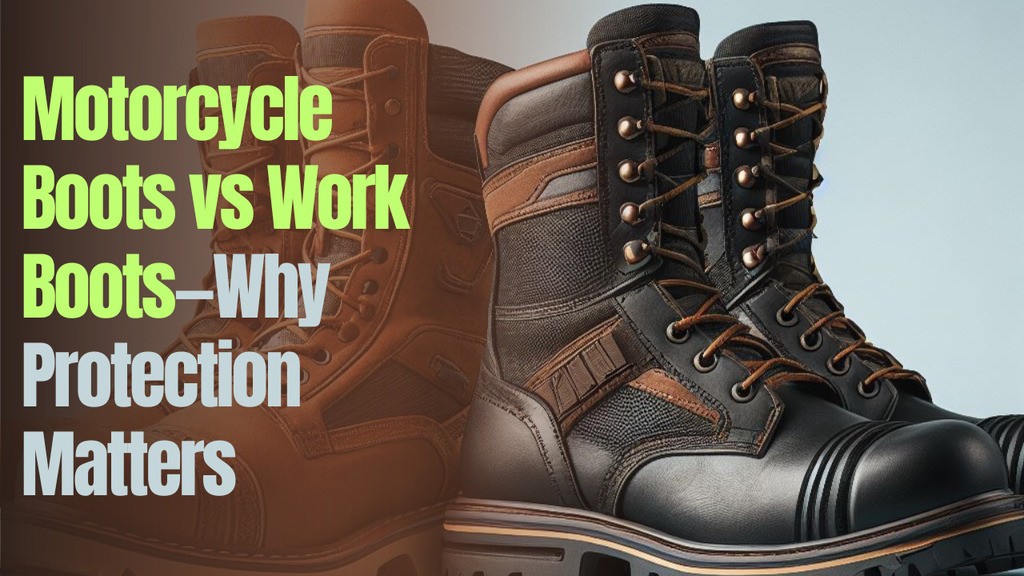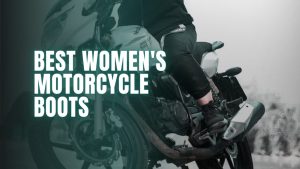In the eternal debate of motorcycle boots vs work boots, which ones really have your back if things go south?
I’ll break down the key distinctions between the two that could make all the difference if pavement ever meets skin. Remember that the right footwear isn’t just about looks – it’s about having gear that’s truly got you covered for wherever the ride may lead.
| Motorcycle Boots | Work Boots | |
|---|---|---|
| Design Focus | Designed for motorcycle crashes/impacts with strict safety standards (e.g. EN 13634) | Designed for safety on job sites against falling objects, etc. but not motorcycle crashes |
| Ankle Protection | Reinforced ankles with stiff plastic/composite shells to prevent bending/twisting | Less ankle reinforcement, often simpler straps without articulating shells |
| Sole Design | Reinforced with crush-resistant materials and shanks to distribute impact force | Thick leather or rubber soles but not reinforced against high impacts |
| Materials | Premium top-grain leather and impact-resistant composites like Kevlar or fiberglass | Material quality varies more with cheaper leather/synthetics used |
| Ventilation | Mesh panels, reinforced vents and perforations for constant airflow | Focus less on ventilation, bulkier materials can trap heat |
| Riding Fit/Feel | Narrow profiles, flex-zones and shifter pads for precise control | Wider profiles, bulkier construction for less peg feel/control |
| Safety Standards | Tested to motorcycle-specific standards like EN 13634 for impacts/abrasion | Not tested for motorcycle wrecks, focus on hazards like falling objects |
| Typical Cost | $150-300+ depending on features/brand for entry to premium levels | $150-300+ depending on features/brand, less focus on abrasion/impacts |
| Best Application | Motorcycle riding for proven impact/crash protection | Job site work for basic foot safety requirements |
Motorcycle Boots vs Work Boots: Design Differences
The design is where you really see the differences in protection between motorcycle boots and work boots.
Boots for a rider are purpose-built with crashes and impacts in mind, while work boots focus more on safety on the job site.
Motorcycle Boots Design Features
a. Reinforced Ankle Protection
In a fall, the last thing you want is for your ankle to twist the wrong way. Motorcycle boots use stronger and stiffer materials like reinforced leather or plastic around the ankles. This helps prevent bent or broken ankles if you go down.
I’ve heard too many scary stories of people wrecking in regular shoes or boots and ending up with snapped ankles and months of rehab. The ankle reinforcements in proper motorcycle boots could save your bacon in a crash.
b. Impact-Resistant Soles
The soles of motorcycle boots are also built differently. Work boot soles are sturdy, but motorcycle boot soles have reinforcement to take more of an impact if your foot gets jammed between the asphalt and peg or some other hard object.
Smashing your foot at 30+ mph wouldn’t feel great, even with a steel toe! The reinforced shanks and materials in motorcycle boot soles can really make a difference here in protecting precious tootsies.
c. Shifter-Friendly Design
Ever try to blip the throttle or roll through gears in a pair of clunky work boots? Not fun! Motorcycle boots are shaped with ergonomics in mind.
Thin soles and padding around the toe area help you feel more connected to the shift lever or pedal. The pads are also tougher materials to resist wear from repetitive use of the gear selector. This makes for more confident shifting whether you’re on a sportbike or cruiser.
d. Safety Standards
Motorcycle boots are also tested to industry safety standards, like the European EN 13634 for impact and abrasion resistance. This ensures the materials and construction actually deliver on protecting your mitts in a crash scenario.
Work boots may meet standards too for job sites, but their testing doesn’t simulate motorcycle wrecks. So for riding, boots designed and proven for motorcycle impacts are always the safer bet.
While your work boots might SEEM protective enough, closer inspection shows motorcycle boots are simply built differently, and that difference could make all the difference if you ever encounter a spill. The designs have their reasons, so it’s worth investing in a good pair of motorcycle-specific boots if you’re a rider.
Work Boots Design Features
a. Made for the Jobsite, Not the Road
While work boots are heavy-duty footwear, their designs prioritize a different kind of safety compared to motorcycle boots.
See, most work boots are made with long days on rough terrain in mind. The focus is on protecting your toes from heavy objects accidentally dropping on them. So they’ve got sturdy steel or composite toes to shield your digits from hammer smashes and such.
Now don’t get me wrong, a reinforced toe box is never a bad thing. But motorcycle boots take protective features a step further since crashes pose different dangers than construction sites. When your 300-pound bike lays down on the highway, a steel cap may cut your toe off.
b. Lacking in Ankle Protection
Another thing work boots may skimp on is ankle support. With a day on your feet on uneven ground, too much rigidity can ache real bad real fast. So while work boot ankles are rugged, they tend to be simpler straps and materials rather than the articulated plastic shells found in motorcycle footwear.
Problem is, a simple strap won’t do anything to prevent a serious twist if your leg gets pinned under a felled machine or busted motorcycle. The ankle armor in proper motorcycle boots is engineered to help keep those cheap joints intact even in a high-speed incident.
Work boots are stellar for stomping beams, dodging drywall screws and braving baking slag heaps, but their designs don’t truly match up to the demands of motorcycle accidents. And in a spill, the last thing you want is the limits of workwear leaving you limping instead of riding.
Motorcycle Boots vs Work Boots: Differences in Materials
In a motorcycle boots vs work boots face-off, the materials make a big difference in what happens after a slide.
Leathers Made to Last
Motorcycle boots rock top-grain leathers that are specially tanned and treated to hold up against road rash. We’re talking the good stuff -thick but still supple enough to stitch into all sorts of high-abrasion panels and protections.
These leathers can take a real whooping like few others can. Just ask any rider who’s been down – they’ll tell you the boots were one of the only things to make it out relatively unscathed! And even after resurfacing the road, those leathers will barely have a scratch.
Work Boot Leathers: Hit or Miss
Work boot leather quality varies more. Sometimes you get tough leather that’ll endure years of abuse. But it’s just as likely to be on the thinner, lower-grade side.
While sturdy, it might not compare to the burnishing and abrasion wizards in motorcycle gear. And one big slide could see those work leathers looking raggedy fast.
Reinforced to the Max
To really amp up durability, motorcycle boots pack in reinforcements like Kevlar, nylon shrouds, and fiberglass where needed. Impact zones especially get the bulletproof treatment.
This delivers serious strength without bulk. Much nicer than a multi-ton truck crushing those toesies, amIright?
So if you’re looking for materials that’ll serve you far beyond just one season, the premium hides and composites in motorcycle boots are made for the long haul – whether on the factory floor or open road.
Work Boot Materials: A Crapshoot
The work boot materials are more of a crapshoot. Construction can range anywhere from decent leather to thinner synthetics to rubberized nylon. And it’ll vary a lot between brands and price points.
The bargain basement pairs might be good for a few months before they start peeling off in strips. And anything but top-grain leather won’t have the grain and waxing that builds up the thickest abrasion layers.
Nowadays some work boots use composite materials too. While lighter, they may not breathe as well on hot rides. And how those composites react in a slide is anyone’s guess compared to proven leathers.
At the end of the day, work boots need to focus on value, all-day comfort, and whatever safety features fit their price. Durability takes a back seat since they’re not designed for epic tarmac tangles like motorcycle footwear.
So if long-lasting materials matter when your life hits the pavement, it pays to pony up a bit more for the top-shelf leathers and composites guaranteed to perform after a spill. The added security is well worth it versus relying on work boots built to lesser standards.
Riding Ergonomics of Motorcycle and Work Boots
When every millimeter counts, boot design directly impacts how you handle the bike. And in the motorcycle boots vs work boots showdown, ergonomics give motorcycle-specific pairs the edge.
Fit for the Pegs
Narrow profiles and slim sole shapes on motorcycle boots marry perfectly to footpegs. High-grip rubber or composites let your feet cling with precision. This extra control and feedback keeps you confident clipping through corners.
Shifter Love
Protective shifter pads cradling the toe box let you pop through the gears without scuffs or slips. The flex grooves also enhance sensitivity at the lever or gear selector. Smooth shifting makes every ride more enjoyable.
Work Boots: Bulkier Buddies
Work boots, while protective, add more bulk between you and the pegs. Wider toes and thicker soles kill some of that connectivity. Finding neutral or tapping the shifter takes more thought.
Plus your desire to keep boots lacquered may clash with wear from shifter action. So harnessing the bike’s full potential takes more effort.
Cost Comparison: Motorcycle Boots vs Work Boots
When it comes to motorcycle boots vs work boots, price often factors into the choice. But is a few extra bucks really worth the risk?
Entry Level Spend
Decent entry-level motorcycle-specific boots start around $150-$300 bucks. At that point, features include leather uppers, steel shanks, and ankle armor – the basics for coverage.
In comparison, some work boots fall in the same range. But options under $200 tend to use thinner materials and composites versus top-grain leather.
High-End Hits Harder
Once you get into premium gear from top brands, both motorcycle boots and high-end work boots can easily clear $300 and beyond. At this level, you’re paying for lightweight composites top-shelf leathers, and advanced safety features.
Value in Protection
While they dent the wallet initially, motorcycle boots pay dividends in peace of mind. The incremental cost ensures crucial ankle, sole and upper protection is there if/when you need it.
Compare that to rolling the safety dice with work boots reliant on a steel toe alone. One crash could equal lifelong medical bills – much pricier than any boots!
FAQs About Motorcycle Boots and Work Boots
Can I wear my work boots occasionally when running errands on my motorcycle?
We don’t recommend wearing work boots for regular motorcycle use. While they may seem protective, they lack features like ankle armor, advanced soles, and have bulkier fits that reduce riding control. Slippery soles or inadequate ankle support increase injury risks in a crash.
Can motorcycle boots be worn for casual activities as well as riding?
Absolutely! Many riders use their motorcycle boots as go-to footwear even when not riding. Since styles are often similar to hiking or work boots, they work well for casual wear. And premium leathers make them durable enough for daily use.
Do motorcycle boots work for dirt biking or are separate boots needed?
Motorcycle boots should provide basic protection for dirt riding. However, dirt bike-specific boots offer reinforced heels/shins and tread for riding techniques like placing feet out. They may also drain water better and provide more ankle flex.
How long do high-quality motorcycle boots last with regular use?
Top-grain leather boots from reputable brands typically last 2-5 years or more with regular care and seasonal riding. Leather wears more on the heels and toes but can often be resoled 1-2 times to extend life further. Frequency of use, riding conditions/weather, and care all factor into boot lifespan.




